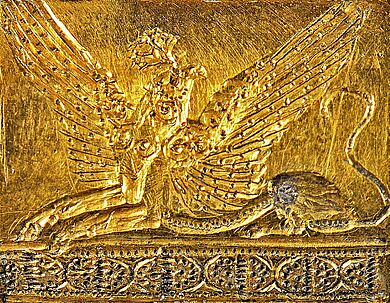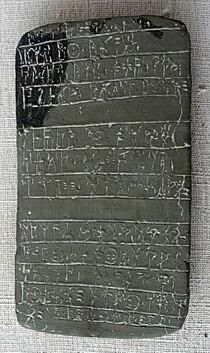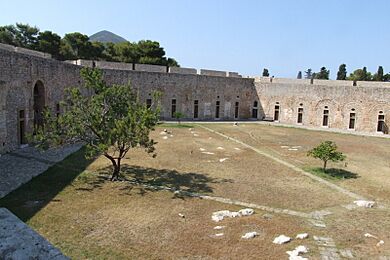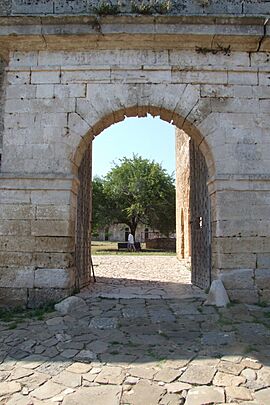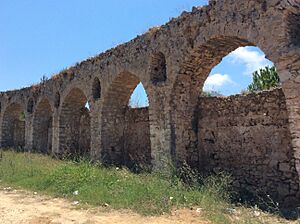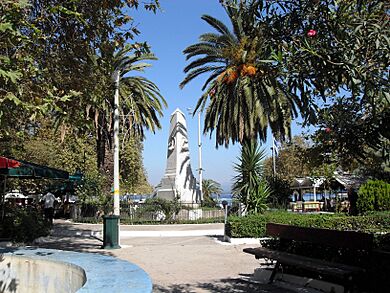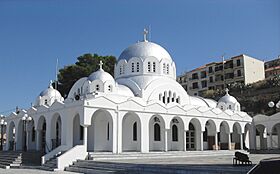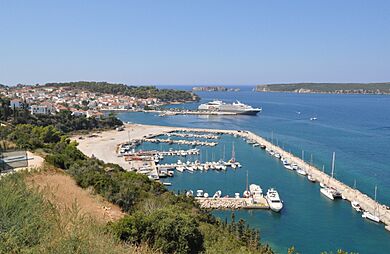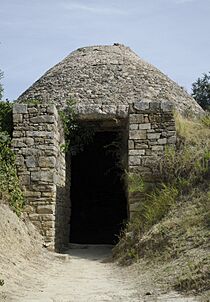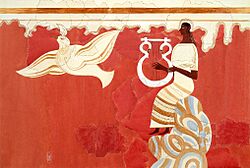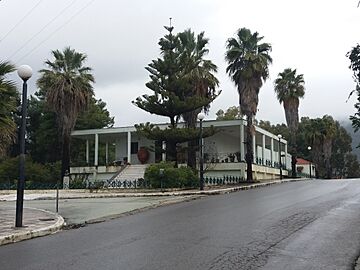Pylos facts for kids
Quick facts for kids
Pylos
Πύλος
|
||
|---|---|---|
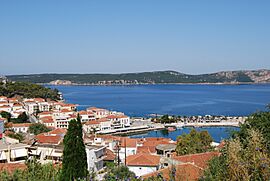
The bay of Pylos
|
||
|
||
| Country | Greece | |
| Administrative region | Peloponnese | |
| Regional unit | Messenia | |
| Municipality | Pylos-Nestoras | |
| • Municipal unit | 143.91 km2 (55.56 sq mi) | |
| Elevation | 3 m (10 ft) | |
| Population
(2021)
|
||
| • Municipal unit | 4,559 | |
| • Municipal unit density | 31.680/km2 (82.050/sq mi) | |
| Community | ||
| • Population | 2,568 (2021) | |
| Time zone | UTC+2 (EET) | |
| • Summer (DST) | UTC+3 (EEST) | |
| Postal code |
240 01
|
|
| Area code(s) | 27230 | |
| Vehicle registration | KM | |
| This article contains special characters. Without proper rendering support, you may see question marks, boxes, or other symbols. |
Pylos (pronounced PY-los) is a town in Messenia, Peloponnese, Greece. It was once known as Navarino. Pylos is a municipal unit and the main port on the Bay of Navarino. It is part of the larger Pylos-Nestoras municipality.
Pylos has been lived in since ancient times. It was a powerful kingdom during the Mycenaean period, home to the famous "Palace of Nestor". This palace is named after Nestor, a king of Pylos mentioned in Homer's Iliad. Later, in Classical times, Pylos was the site of the Battle of Pylos in 425 BC, during the Peloponnesian War. Over the centuries, Pylos was ruled by different groups, including the Franks, Venetians, and Ottomans. The Ottomans built a new fortress here.
In 1827, a very important event happened in the Bay of Navarino: the Battle of Navarino. This naval battle helped Greece gain its independence from the Ottoman Empire. The modern town of Pylos was built after this war, starting in 1829.
Contents
What's in a Name?
Pylos has had several names throughout history. Its ancient name, Pylos, was used for a long time.
After the Frankish conquest in the 13th century, two new names appeared:
- Port-de-Jonc: This French name means "Rush Harbour." It came from the marshes around the area.
- Navarino: This name became very popular. It might come from a Slavic word meaning "place of maples."
Under Ottoman rule, the town was called Anavarin. After a new fortress was built in 1571, the local Greeks started calling the old Frankish castle Palaiokastro (meaning "old castle") and the new Ottoman fortress Neokastro (meaning "new castle"). In 1833, the name Pylos was officially brought back for the modern town.
A Look Back in Time
Early Pylos
The Pylos area has a very long history. People have lived here since the Neolithic period (around 6500 BC). This is when farming and raising animals first came to Greece. Digs have found pottery and other items showing people lived here continuously from about 5300 BC.
Mycenaean Pylos
During the Bronze Age (3000–1000 BC), the Mycenaean civilization grew strong, especially in the Peloponnese. Pylos became the capital of a very important Mycenaean kingdom. It was known as "sandy Pylos" and was ruled by King Nestor, as described by Homer in his epic poems, the Iliad and the Odyssey.
The Mycenaean kingdom of Pylos was quite large, covering about 2,000 square kilometers. It had a population of at least 50,000 people. The main center of this ancient city was the Palace of Nestor. This palace is located on a hill called Ano Englianos, about 9 kilometers northeast of the modern Bay of Navarino.
The Palace of Nestor is one of the best-preserved Mycenaean palaces in Greece. It was discovered and first dug up in 1939 by American archaeologist Carl Blegen. Inside, he found amazing things like a throne room with colorful frescoes, large storage rooms, and even ancient baths.
Blegen also found thousands of clay tablets with writing on them. This writing is called Linear B, a special script used by the Mycenaeans. In 1952, experts figured out that Linear B was an early form of the Greek language. These tablets show that the Mycenaeans themselves called their city "Pylos."
In 2015, archaeologists found a very important tomb near the palace. It belonged to a warrior, now called the "Griffin Warrior," because of a cool ivory plaque found there. The tomb was full of amazing items like armor, weapons, and gold jewelry. In 2017, two more tombs were found, containing even more treasures, including a gold pendant of the Egyptian goddess Hathor. This shows that Pylos traded with Egypt and the Middle East around 1500 BC.
Pylos was unique because it didn't have strong walls or fortifications. Around 1180 BC, the palace was destroyed by a big fire. The clay tablets found there show that people were preparing for an attack, but we don't know who attacked them. After this, Mycenaean Pylos seems to have been abandoned for a long time.
Classical Pylos
During the Peloponnesian War, Pylos became important again. In 425 BC, the Athenians built a fort on a rocky point called Koryphasion, at the northern edge of the bay. This led to a famous battle.
The Athenians trapped a group of Spartan soldiers on the nearby island of Sphacteria. This event was a big deal in the war. The Spartans were so worried about their captured soldiers that it helped lead to a peace treaty in 421 BC.
Middle Ages
Not much is known about Pylos during the Byzantine period. In 1204, after the Fourth Crusade, the Peloponnese became a Crusader state called the Principality of Achaea. In the 1280s, the Franks built the Old Navarino castle here.
Later, the Republic of Venice took control of the fortress in 1417. They held it until 1500, when the Ottoman Empire conquered it.
Ottoman and Venetian Rule
The Ottomans used Navarino as a naval base. In 1572, they built a new fortress called Neokastro (meaning "new castle") to replace the older Frankish one.
The Venetians briefly took Navarino back in 1685 during the Morean War. They ruled it as the "Kingdom of the Morea" until 1715, when the Ottomans recaptured the Peloponnese.
The Greek War of Independence (1821)
When the Greek War of Independence began in 1821, Greek fighters besieged Navarino. They captured it in August, but sadly, many of the Muslim inhabitants were killed.
However, the Ottoman Sultan asked for help from Muhammad Ali, who sent his son Ibrahim Pasha of Egypt with a large army. Ibrahim Pasha recaptured Pylos in 1825.

Many people in Europe, especially artists and writers, supported the Greek cause. After the fall of Missolonghi in 1826, where the poet Lord Byron had died, sympathy for Greece grew.
In July 1827, France, Russia, and the United Kingdom signed a treaty to help Greece. They sent a fleet of 27 warships to put pressure on the Ottoman Empire. On October 20, 1827, this Allied fleet completely destroyed the Ottoman-Egyptian fleet in the Battle of Navarino. This battle was a major turning point and helped Greece win its independence.
A monument shaped like an obelisk stands in Pylos's main square, honoring the three admirals who led the Allied fleets: Edward Codrington (British), Henri de Rigny (French), and Lodewijk van Heiden (Russian).
Building the Modern City
On October 6, 1828, Pylos was finally freed from Ottoman-Egyptian control by French troops led by Marshal Nicolas-Joseph Maison. These troops were sent to help Greece become an independent state.
The current city of Pylos was built starting in 1829, just outside the walls of the Neokastro. Its design was created by Joseph-Victor Audoy, a French military engineer. The city plan was approved in 1831, making it one of the first planned cities in modern Greece. Many improvements were made, including building barracks (now the Archaeological Museum), schools, a hospital, and restoring the old Ottoman aqueduct. The first road in independent Greece, connecting Navarino to Modon, was also built by French engineers.
In 1833, after the French troops left, the new city of Navarino was officially renamed "Pylos" by King Otto I, in honor of the ancient city of King Nestor.
20th Century Pylos
The fortress of Pylos was used to hold political prisoners between 1936 and 1941. Pylos was an important administrative center for many years. Since 2011, it has been the seat of the new Municipality of Pylos-Nestor.
Pylos Today
Location and Features
Pylos is located at the southwestern tip of the Peloponnese, on the Ionian Sea coast. It sits at the foot of a hill with the Neokastro fortress on top. The narrow island of Sphacteria acts as a natural barrier for Navarino Bay, making Pylos's port one of the safest places for ships to anchor on the Ionian coast.
Getting Around
Pylos has good roads. Greek National Road 82 connects Pylos directly to Kalamata in less than an hour, and from there, you can reach Athens in about two hours. Kalamata International Airport is expanding and offers flights to major Greek cities and international destinations during tourist season.
Population
According to the 2021 census, the municipal unit of Pylos has 4,559 inhabitants. The town of Pylos itself has 2,568 inhabitants.
| Year | Community population | Municipal unit population |
|---|---|---|
| 1981 | 2,107 | – |
| 1991 | 2,014 | 5,340 |
| 2001 | 2,557 | 5,251 |
| 2011 | 2,767 | 5,287 |
| 2021 | 2,568 | 4,559 |
Exploring Pylos
Pylos has two castles: the Frankish Paleokastro (old castle) and the Ottoman Neokastro (new castle).
- The Paleokastro is northwest of Navarino Bay, on top of the Koryphasion promontory. It offers amazing views of the Ionian Sea and the Pylia Plain. Below it, you can find Nestor's cave and the beautiful Voidokilia beach. The Paleokastro is quite old and worn, so be careful if you visit.
- The Neokastro is southwest of the bay, overlooking the city. It is one of the best-preserved castles in Greece. Inside its walls, you'll find the well-kept Church of the Transfiguration of the Savior, which was once a mosque. The old barracks built by French troops are also here, now housing the new Archaeological Museum of Pylos.
South of Pylos, you can see parts of the old Navarino aqueduct. It was built in the 16th century by the Ottomans to bring water to the Neokastro. French engineers restored it in 1832, and it supplied Pylos with water until 1907.
Pylos City Center
Pylos is built on two hills, facing the Bay of Navarino. Many 19th-century stone houses with traditional Messenian architecture can be found here, often with spacious courtyards. The streets are narrow and often paved with stone, with some pedestrianized streets climbing the hills.
The central city square, called the Square of the Three Admirals, is near the seafront. It's surrounded by buildings with arcade galleries, where you'll find markets, shops, and cafes. The seafront has a pedestrian street leading to the modern port, with traditional fish taverns. The City Hall of Pylos overlooks the port.
Near the City Hall is the renovated house of Konstantinos Tsiklitiras, an Olympic champion. It now houses a museum with paintings and old documents. Further along the seafront is the historic College of Pylos building. It used to house the "Nestor" Institute of Physical Astrophysics, which works on an underwater neutrino detector deep in the Mediterranean Sea. This historic building will soon become the public library and gallery for Pylos.
Pylos also has banks, a post office, clinics, a fire station, schools, and a music conservatory.
The Central Square of the Three Admirals
The central square of Pylos was also built by French troops in 1829. It has a unique triangular shape, with one side opening to the sea. The other sides are lined with covered galleries and arcades, similar to squares in Southwest France and the Ionian Islands. These galleries are home to many shops and cafes, with outdoor seating under large, old plane trees.
In the center of the square, surrounded by two tall phoenix trees, is an obelisk monument. It commemorates the Battle of Navarino and honors the British, French, and Russian admirals who led the Allied fleets to victory.
Churches
Pylos has two main churches:
- The Church of the Dormition of the Virgin Mary (Ieros Naos tis Kimiseos tis Theotokou) is on the eastern slope of Pylos hill. It holds regular services and is especially popular during Easter and the Myrtidiotissa Virgin celebration, attracting many visitors.
- The Church of the Transfiguration of the Savior (Ieros Naos tis Metamorphosis tou Sotiros) is inside the Neokastro. It is now used as a museum and exhibition center.
The Port and Marina
The port of Pylos is known as one of the safest places for ships in the Mediterranean Sea. Navarino Bay often provides shelter for ships during storms. Its location between the Ionian Sea and the Aegean Sea makes it a good stop for ships traveling to the Cyclades, Dodecanese Islands, or Crete. Many cruise ships visit Pylos during the summer. There is also a marina in Pylos, which is being modernized to support the growing tourism in the area.
Around Pylos
The Palace of Nestor
North of Pylos (about 17 km away) and south of the town of Chora, is the hill of Ano Englianos. This is where you'll find the Mycenaean Bronze Age palace known as the "Palace of Nestor" (1600–1200 BC). It's the best-preserved palace from the Mycenaean civilization in Greece.
The palace ruins include the throne room, storage areas, unique baths, and a 90-meter-long beehive tholos tomb (a round burial chamber with a dome), which was restored in 1957. Recent discoveries include the "Griffin Warrior" tomb (2015) and two other tholos tombs (2017). These tombs contained incredible artifacts and jewelry, like the Pylos Combat Agate and a gold pendant of the Egyptian goddess Hathor. These finds show that Pylos traded with Egypt and the Near East around 1500 BC.
The site reopened to the public in June 2016 after renovations. You can visit the archaeological site of the Palace of Nestor every day, except Tuesdays and holidays.
The Archaeological Museum of Chora
The archaeological museum is in the center of Chora village, 4 kilometers north of the Palace of Nestor. It was built in 1969 to display items found at Nestor's Palace and the surrounding area.
The museum has three rooms. The first room shows items from tombs, like pots, weapons, and jewelry. The second room has finds from the Palace of Nestor, including large storage jars, pottery, and wall frescoes showing scenes like a lyre player with a bird, and war or hunting. The last room displays more finds from the palace and tombs, such as giant vases, cups, and jewelry. The Archaeological Museum of Chora is open every day, except Tuesdays and public holidays.
Gialova Lagoon and Beaches
North of Navarino Bay, near the village of Gialova, is the Gialova wetland. This is one of Greece's most important lagoons and a Natura 2000 network site, known for its natural beauty and as a key bird area in Europe. It's also a large archaeological site.
The lagoon is a shallow lake, no more than four meters deep, and is an incredibly important bird reserve in Europe. It's the southernmost stop for migrating birds traveling between the Balkans and Africa. Over 270 bird species live here, including greater flamingos, glossy ibis, and various herons. A very rare species, the African chameleon, also lives here. You can visit an observation post to learn more about the birds and walk paths around the lagoon.
At the western end of the lagoon is the small Bay of Voidokilia. Its beautiful cove-shaped beach is often ranked among the most beautiful in the world. It's bordered by the Divari lagoon, the Ionian Sea, and Navarino Bay. Voidokilia beach is also part of the Natura 2000 network. It's free to access and can be reached by road or path. On the northern side of the lagoon, there's a Mycenaean beehive tholos tomb known as "Thrasymedes" (son of King Nestor). Higher up, near the Paleokastro, is "Nestor's Cave," where mythology says the king raised his oxen.
Along the road from Voidokilia to Gialova, you'll find a long white sandy beach called the Golden Coast Beach (Paralia tis Chrysis Aktis) or Divari beach. It runs along Navarino Bay and connects to Gialova beach within the village.
Events
Every year around October 20, the "Navarinia" celebrations take place in Pylos. These events remember the Battle of Navarino (October 20, 1827). The celebrations last several days and end with a big event in Pylos port. The Hellenic Navy and representatives from the United Kingdom, France, and Russia take part.
Frigates and old sailing ships recreate the famous battle with an amazing sound and light show. The evening often ends with fireworks. Other cultural events, like ceremonies, conferences, parades, and traditional music and dance, also happen during the "Navarinia." These celebrations attract many visitors. In 2020, the "Navarinia" won a "Gold Tourism Award" for Cultural Tourism.
Famous People from Pylos
- Nestor: A hero from Greek mythology and the legendary king of Pylos. In Homer's stories, he is known as the oldest and wisest hero of the Trojan War.
- Edward Codrington (1770–1851): A British admiral who led the British fleet during the Battle of Navarino.
- Lodewijk van Heiden (1773–1850): A Russian admiral who commanded the Russian fleet at the Battle of Navarino.
- Henri de Rigny (1782–1835): A French admiral who led the French fleet during the Battle of Navarino.
- Nicolas-Joseph Maison (1770–1851): The main commander of the French Morea expedition (1828–1829), which helped liberate Pylos.
- Joseph-Victor Audoy (1782–1871): A French military engineer who designed the first urban plan for modern Pylos in 1829.
- Carl Blegen (1887–1971): An American archaeologist who led the first excavations of the Palace of Nestor.
- Konstantinos Tsiklitiras (1888–1913): An Olympic champion athlete from Pylos. He won medals in standing long jump and standing high jump at the 1908 and 1912 Summer Olympics.
- Antonis Samaras (1951–): A former Prime Minister of Greece (2012–2015) and a Member of Parliament for the Pylos region.
See also
- List of settlements in Messenia




